Menus
- Italian Sport Touring put to the test for two years over 18,000 km
- A welcome evolution of the Angel GT
- Discovery
- In the city
- On the road
- On the highway
- In the wet
- Longevity / wear
- Conclusion
- Pirelli Angel GT II tire dimensions
- Indicative price of Pirelli Angel GT II tires
Italian Sport Touring put to the test for two years over 18,000 km
After the Bridgestone T32, it’s the Pirelli Angel GT II’s turn to pass through our hands, at least on our wheels, to undergo a ruthless test. In the Sport GT tire market, Pirelli has been a reference with a sporting connotation since the release of its Angel GT (2013) followed in 2019 by its second generation with the Angel GT II. Wanted more road, claimed to be the most enduring of "touring" tires, we put it to the test for … 2 years …. Verdict.
It’s not every day that you can run a Sport GT tire test at the same time as a long-term test. But that’s what we did with the Angel GT IIs. II as the second generation, II as two years since they came out and finally II as the 2 of 2 x 9,000 km, the total mileage – rounded – of our test on our sports car accompanied by a new test over 3,000 km on the last one. Yamaha Tracer 9 during our last Biker Break. So, from round to square tires, what is our opinion on the Angel GT II ?
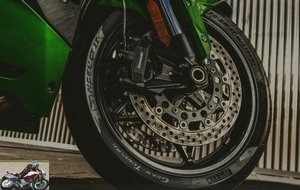 Long-term test of Pirelli Angel GT II tires
Long-term test of Pirelli Angel GT II tires
A welcome evolution of the Angel GT
In June 2019, we mounted on our test CBR 1000 RR a train of the newly released Pirelli Angel GT II, the latest Italian brand touring tires and replacements for the Angel GTs released in 2013, which had sounded the death knell for the Angels. ST, who themselves succeeded the Diablo Strada. In our full test, we spared it nothing. Starting with an ultra rainy baptism at the end of their "break-in", at least of our contact of nearly 500 km. And of course, we were able to verify throughout their lives whether they were able to keep the promises made by the manufacturer’s speech. Namely: durability increased by 30% (!), Better handling and therefore, much better in the wet.
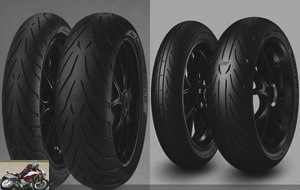 Angel GTs (left) versus Angel GT II (right)
Angel GTs (left) versus Angel GT II (right)
Pirelli has already revised the structure of its tires. The 0 ° steel belt is still one of the techniques used, but it is no longer the exclusive feature of the brand since the process entered the public domain. The density of the wire winding (in the "vertical" direction) varies according to the angle taken and becomes stronger as you reach the shoulders. The latter are also very round, compared to what you can see on more sporty tires. The surface contact with the ground is, however, claimed to be important, in order to maximize the grip, which is also due to the rubber compound. Likewise, the carcass plies and the multi-spoke profile (therefore the structure in the form of arches perpendicular to the belt) offer, in the horizontal direction this time, a work and a distribution of the forces supposed to improve the comfort and once again. , the life of the tire. Noted.
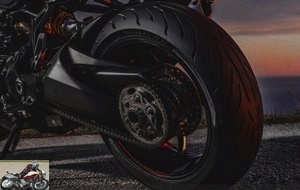 The GT II has a very round profile
The GT II has a very round profile
Stingy in denominations compared to what we find at Bridgestone (see our test of the T32), Pirelli prefers to say that we find technology from the Superbike in its tire, especially in terms of design (the lines on the tread), or the rubber which we are told is similar to that of the "Wet" tire in places and whatever happens wanted more grip in all road conditions. So we won’t know much more, but the main thing is elsewhere: on the handlebars.
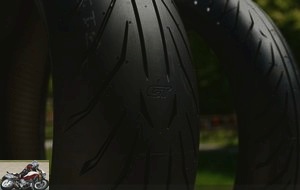 The design always takes the form of angel / demon with the GT logo which fades over the miles
The design always takes the form of angel / demon with the GT logo which fades over the miles
It is therefore on the chemistry that we will make the difference and on the internal composition of the tire. But especially on asphalt, whatever its condition. The Italian manufacturer also mentions a significant increase in comfort. Pirelli did not reinvent the gum and its compound results from a dosage between carbon black and silica (to summarize). The architecture of the tire, on the other hand, has evolved, in particular through the carcass, which affects the distribution of the force, influences the heating time and the longevity of the tire through its deformations. The comfort previously mentioned is also directly impacted. Finally, the profile of the tire naturally influences handling and angle setting. As such, if the rear tire is dual-compound, with a hard central tread and narrower than on its predecessor (the GT), the front tire remains single-compound, as we have also seen on the competition. more direct and recent (T32). In fact, the wear should be more even, more even and without demarcation between the center and the sides. Does the Angel GT II retain its properties, road feel and behavior throughout its life? The answer right after we refreshed our memories with a Ducati Supersport 950 S decked out in new GT IIs.
Discovery
A new tire is beautiful. And suddenly, our test started with a complete assembly mounted on the very last Yamaha Tracer 9. Suffice to say that we were on eggshells for the first kilometers, just before taking a sauce as rarely accompanied by hail on a portion of the highway. This did not prevent us from driving largely on the legal motorway as if we were driving in dry conditions. The first contact was therefore good, including in the wet, but in a fairly neutral way..
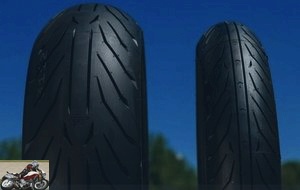 Already tested over 18,000 km with the CBR, we took control of the GT II with the SuperSport 950 S
Already tested over 18,000 km with the CBR, we took control of the GT II with the SuperSport 950 S
A very large thickness of rubber is noted, the effect of which is to reinforce the depth of the groove in the drawings. It seems that at Pirelli, we compensate for a softer rubber by adding material. As such, if you have motorcycles with power assist, be sure to check if it is not necessary to calibrate the tires after replacement. This was the case on the Supersport and we were able to verify that the responders had never performed the operation. This may explain this in terms of the reaction of the assistance (ABS and traction control). Another point to note: the pressure. Very important in terms of guaranteeing the behavior of a tire, it had been modified compared to the manufacturer’s recommendations (2.5 FWD and 2.9 REV), to be increased to 2.4 at the front and 2 , 6 at the rear, given the temperature conditions, which were relatively high on the day of taxiing in the Vexin. Be careful, however, not to go below these values, you could end up with less grip and a significantly modified feeling..
In the city
Naturally, the Angel GT II do not call for any particular criticism in built-up areas. Grip is retained for a long time, while the front tire absorbs all types of braking in a formidable manner. Without ABS at the front, the CBR sometimes started to feel the tire buckle, mainly at the end of its life, when the tread thickness was less and the ground contact area was greater. However, the braking distances have remained correct throughout the life of the tire and within the average of what the road compounds provide. The CBR tuned even better to the GT IIs, making it very smooth and particularly considerate. Too much even, with a more pronounced feeling of stabilization than with sports tires.
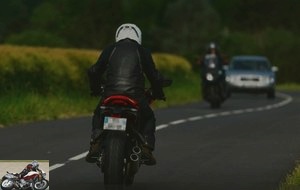 In urban areas, GT II has always been very considerate
In urban areas, GT II has always been very considerate
Still at moderate speed, we find the Angel GT IIs quite agile, with a rather incisive and engaging front, contrasted by a slightly more restive rear in large dimensions (190 on the CBR against 180 on the Ducati). The flat rear profile at the end of the tire life emerges quickly and induces a placement that requires getting used to the phases of corner-to-corner transitions. It is beneficial for in-line stability, but is felt more and more over time, with pronounced wear on the rear tire tread. Concretely, it becomes pronounced square, even when we also approach the wear indicator on the sides, but after 18,000 km. This is the point where the front and rear significantly out of tune over time, with the steer tire maintaining a sharper profile. The bike loses handling and becomes less pleasant to position on the angle at low speed, without ever becoming less reassuring or considerate.
At low speed, bitumen defects are properly filtered. The Angel GT IIs are not too talkative, which is rare for Pirellis, which we know are quick to return a lot of information to the handlebars in order to best inform the riders. Here we are more of a long-haul traveler than a trail-rider and we can afford to water down the matter by providing information mainly on the condition of the road, while coping well with deformations. The tire is rather "comfortable" in the slightly less hard sense of the carcass, with a job well done and there is no need to readjust its suspensions to compensate for the phenomenon..
On the road
First point, the ANGEL GT II have the effect of neutralizing the bike, especially in terms of its direction on the sports car, which has become much less incisive, while keeping a great naturalness. Compared to a sporty ride, we also notice a slower setting on the angle, but a feeling of great holding once stalled and the possibility of easily intervening on the degrees taken: the Angel GT II resist little and show themselves little tiring. It is not until the end of the tire’s life that the transition from one angle to another is less natural, with a two-step registration: the front permanently retains its tempered and well-placed side, while the rear agrees less and less well with him over time and spends an unpleasant area on his "dish". The modification of the rear profile as it wears, creates a notch to pass that can put on the reserve over the kilometers.
But for having reassembled the new tires on the Tracer 9, they bring incredible ease of handling and an easy setting on the angle, even reinforcing the setting on the angle of the motorcycle. And once hot, it looks like glue, so the tire adheres to the road, allowing you to easily and calmly take the angle where other tires do not give the same confidence. And even at the end of our 3,000 km roadtrip, with part of the motorway, the Angel GT II does not seem to be damaged, confirming its potential longevity on road trails. And a fortiori on sports, for having managed to make them take 18,000 km.
And then, afterwards, you can push to start attacking hard. Very strong.
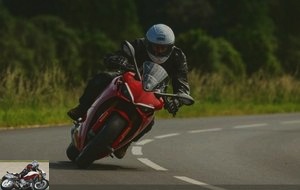 Over the kilometers, the agreement between the front and the rear is reduced when you attack hard
Over the kilometers, the agreement between the front and the rear is reduced when you attack hard
Because when it comes to handling high rhythms, the Angel GT II can handle it. They are able to wedge themselves on their sidewalls, but their very round profile in this lateral zone, mainly at the rear, brings a little less sensitivity than a sport or hypersport tire and a tendency to tip more quickly if the pressure is standard (2.9 bar). On the other hand, the balance on the tread is appreciable and once again, the Pirelli casing is able to maintain good control in the absence of a lot of feedback. Only the last thousand kilometers before reaching the wear indicators are less pleasant, knowing that they have then taken many more kilometers than a sportier tire.
The passage on the Supersport 950 S makes it possible to remember how the new and thick rubber brings serenity to the driving and how the profile is pleasant as long as it does not endure the pangs of the kilometers. The break-in is quick and confidence immediately obtained. Proof of this is the disappearance of the famous "fear bands" after a few tens of kilometers and without driving excessively. The tire really gives you confidence from the start.
 The break-in is done very quickly and the fear bands remain only a few kilometers
The break-in is done very quickly and the fear bands remain only a few kilometers
On the highway
Even if the CBR has rarely put the Angel GT II on the highway at 130, it is clear that the wear is slow and even, especially if we are satisfied with good acceleration to enter the right tape and drive legally. or almost. Here again, the Pirelli are using their profile given to the road exercise. As they say, it goes straight and without gap. Lane changes are a formality, while we appreciate not having to undergo any parasitic movement. The gum wears very evenly and above all, the flat appears gradually and without tearing of material. Front and rear age at the same speed: the indicators are there to remind you that on the angle as on the tread, we reach the limit at the same time. Results ? There is a good chance that you change front and rear at the same time, which is what is recommended when you replace your tires. But this time it’s "programmed" by the tire. For comparison, the CBR normally uses 1 rear for two fronts with softer tires and the same type of use. The Angel GT II is therefore an economical tire to use.
 At high speed, stability is not compromised
At high speed, stability is not compromised
In the wet
Pirelli focused on handling in wet conditions. The Angel GT II claim to have pushed back limits. With road trailering, the Angel GT II provides excellent confidence in the wet. You have to wait for a very significant layer of water on a curve to find the limit of the tire, knowing that the stall is limited and the hooking up is smooth.
 Very reassuring in its early days, the GT II does not offer the same serenity as its more recent competitors as wear and tear sets in.
Very reassuring in its early days, the GT II does not offer the same serenity as its more recent competitors as wear and tear sets in.
Traction on a film of water is good and the tire is particularly reassuring when new. This is evidenced by the hundred kilometers on a soggy motorway carried out in the very first hours of testing the Angel GT IIs. Both braking and acceleration are then as pleasant as possible, while no slipping was to be deplored, despite a maintained speed and water slicks of varying (but high) thickness encountered on the road surface..
Longevity / wear
The CBR drove for 2 years with its Angel GT II. At the start of life, they are particularly convincing and very pleasant, even if one feels that they are much more road than sporty, both in terms of the inscription on the angle and their filtering and reassuring side. Rear tire wear has a significant impact on the behavior of Angel GT IIs, especially on a sports car compared to a road trail or roadster. We have to wait 15,000 km to notice a noticeable disagreement between the front tire and the rear tire, however very gradual disagreement, while remaining assimilable in terms of its reactions and therefore driving. On the other hand, the more we advance in time, the more we are wary ….
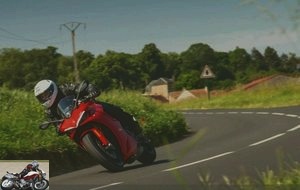 With 18,000 km on the clock, the GT IIs last a long time, but performance is far from constant over time.
With 18,000 km on the clock, the GT IIs last a long time, but performance is far from constant over time.
The wear was particularly even on the tire surface: we hit the wear indicators at the same time both on the front and rear and on the sidewalls and on the tread. Rare enough to be noted. Appreciable, certainly, but if we would have liked the rear tire to retain a certain roundness instead of flattening; but those who drive in the provinces will experience less this inconvenience compared to a more urban and peri-urban use with many straight lines. Moreover, we continue to rely on the grip of the tires on the sidewalls, which retain their grip for the long term. As to whether we would use the same ones, there are several parameters to consider. Longevity is guaranteed, even on a powerful motorcycle. Completing more than 10,000 km is already good and more than 12,000 a high probability, especially if you do not overload your motorcycle and if you regularly monitor the pressure. Changed to 64,000 km on the CBR, the Angel GT II had traveled nearly 18,000 km.
Conclusion
" Near " ? Yes when I bought these tires for my personal bike, I hadn’t actually noted the mileage (buying the bike at the same time). I had not imagined myself one day doing freelance, but pigging to pay them and to ride with the Honda, I was looking for a mount allowing to adopt a sporty driving on the road while being able to cash in the motorway connections in Paris region and daily use, not to mention personal trips on small roads and vacations across France on the coolest possible routes. The opportunity arises today and the bike having completed more than 18,000 km since its purchase (including containment), the Pirelli Angel GT II are rinsed. It would have been possible to pull the rope a little more by going to wear out the witnesses, but what good is it? The average annual mileage of a biker in France is 3,000 km. And a tire ages year after year, even without rolling, by its exposure to the sun and the elements. The Angel GT II will therefore be ideal for heavy riders, who want the comfort and filtration of the road, while being able to achieve significant mileage. After having tested in parallel the Pirelli Diablo Rosso IV on the same Ducati Supersport 950 S and the CBR 1000, I noticed how much the road feel and the behavior on the angle of a sport tire could I miss and how much they were able to improve the handling of a sports car.
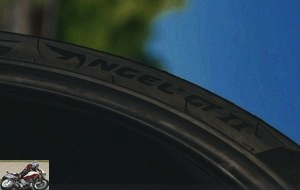 Pirelli Angel GT II review
Pirelli Angel GT II review
The Angel GT II are therefore an excellent tire when it comes to adapting to any type of motorcycle, but sports cars bring out their profile and their stabilizing capacity, even if it means giving up the full capabilities of the motorcycle if one wishes. exploit it fully. They go wonderfully with the latest generation roadsters and larger or smaller roadsters, which know how to make better use of their structure. When it comes to dry sport, the GT IIs don’t let that down. However, Pirelli does not mix rubber and the Italian brand is keen to differentiate its sport range and its road range. This is evident once we can compare the last two generations of each representative. The GT II are cut for the roads. All the roads and they go the distance.
Strong points
- Fearsome front tire
- Handling on the corner
- Progressive stall in the wet
- Appreciable comfort
- Convincing longevity
Weak points
- Profile of the rear tire over time
- Neutralizes the direction
- Angle limits difficult to determine
- Tire wear in pairs a priori
Test conditions
- Itinerary: daily for two years
- Mileage: 18,000 km
Pirelli Angel GT II tire dimensions
| Before | Back |
|---|---|
|
|
Indicative price of Pirelli Angel GT II tires
- Front tire: approx. 120 € in 120/70 – 17
- Rear tire: approx. 145 € in 180/55 – 17
Related articles
-
Pirelli Diablo Rosso IV tire test
The devil in detail ! The Diablo Rosso IV is the latest Pirelli sport tire and yet intended for road use. The latest tire once again sets the bar very…
-
Pirelli Diablo Rosso II tire test
The successor of the diablo Rosso enters the era of the bi-eraser The days of the diablo Rosso are numbered. After 3 years of existence, he will…
-
Pirelli Diablo Rosso Corsa II tire test
Does he really have the devil in his body ? New blood But what the hell is going on on the other side of the Alps? Has the sports tire specialist fallen…
-
Bridgestone T32 and T32 GT tire test
The do-it-all Sport Touring tire 22 sizes and a GT version Since Bridgestone has renamed its tires with clear names, it is much easier to navigate than…
-
The fifth element in 3D version A scent of competition for the tire of Clermont, which succeeds the Pilot Road 4 The Road5 is the brand new Michelin tire…
-
Bridgestone Battlax Hypersport S22 motorcycle tire test
The street racing tire according to Bridgestone The successor of the S21, the new hypersport road tire from Bridgestone is called S22. We discovered him…
-
The Sicilian Clan Pirelli invited us for a life-size test drive on the back roads of Sicily with the Angel ST. Rather new conditions that change the…
-
Metzeler Sportec M9 RR tire test
Sporty road tire The top of the pure road range in terms of sales and performance, the M7 RR tire is almost a monument as it is crowned with victories in…
-
Hypersport radial tire test at the Abu Dhabi F1 circuit Faster and further For the presentation of its new hypersport road tire, Bridgestone had put the…
-
Pirelli Diablo Rosso III tire test
A single-compound front hypersport-road tire, dual rear compound Road and circuit tire test, in – almost – dry, wet and cold conditions Pirelli renews…
Beam frame, liquid cooling, big exhaust, false tank … It is too sophisticated to benefit from the same vintage charm of Mash and Brixton. When I was riding a Mash, I was often approached to discuss this "pretty little bike". I doubt this will be the case for future owners of this non-вme XSR. Which is arguably a very good bike technically, though.
Knowing the Den testers, I doubt this is the case .
.
You don’t have to burn with every fire either.
On this one, the "awkward faux vintage" aesthetic of the other XSRs doesn’t bother me at all..
She’s not bad at all.
A little mess of hoses on the right side. We are no longer in the reign of the plastic cover.
It presents a rather good quality / price ratio, and it is quite rewarding. Indeed, as always with Yam there is always a mess under the tank, but the yellow version with the optional fork crown is particularly attractive..
Cherry on the cake, it is made in France. It is more expensive than a chinoiserie, but at least it comes out more than 11 hp and does not come with wooden tires.